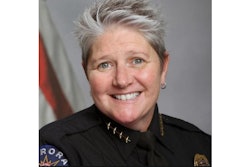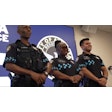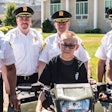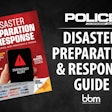Police departments and agencies across the country are setting their sights on employing more women as sworn officers. The benchmark of police recruit classes reaching 30% women by 2030 was set as a goal when the 30x30 Initiative launched just over a year ago. Another part of the goal is to ensure police policies and culture intentionally support the success of qualified women officers throughout their careers.
In just a little more than a year, departments from across the country have already signed the pledge to take strides toward that 30 percent goal. Kym Craven, executive director of the National Association of Women Law Enforcement Executives (NAWLEE), says currently women make up slightly less than 13 percent of the sworn officers in the United States.
Although 2030 is still eight years away, Craven points to several examples of departments that recently had higher percentages of women in recruit classes. She said in Madison, WI, police had a class that was 20%, Nashville Metro PD just had one that was more than 40% women, and LAPD had one class nearing 50% women.
“What agencies have found is that it can be done,” Craven says.
NAWLEE has had a stake in the initiative from the beginning since it was co-founded by the Policing Project at New York University School of Law and NAWLEE. The 30×30 Initiative, which is run by the NYU School of Law Policing Project, is based on the importance of achieving at least 30% representation to empower a group to influence an organization’s culture.
The spark that led to the initiative started when retired Newark Police Chief Ivonne Roman approached Maureen McGough of the National Institute of Justice, the research and development arm of the U.S. Department of Justice. As a result, the NIJ hosted the Research Summit on Women in Policing at its Washington, D.C., headquarters in December 2018. They brought together more than 100 women representing law enforcement leadership, researchers, and organizations
“They brought us all together and we talked about some of the barriers and some of the successes of women in law enforcement,” said Craven. “Through that summit there was a document that was created called Breaking Barriers. That was the outcome of our session.”
Women in Policing: Breaking Barriers and Blazing a Path, the July 2019 special report by NIJ, says, “The goal of the summit was to understand the current state of research relevant to women in American policing, and to generate a research agenda of questions that women leaders in the field have identified as priorities in moving the profession forward toward parity.”
That report, and the research results, provided a framework of steps departments can take concerning women in law enforcement. From there, work began and the 30x30 Initiative is the result.
“The Policing Project at the New York School of Law and NAWLEE are the founding partners to launch it with the entire steering committee, so it is truly a collaborative effort between many organizations,” explains Craven. “There was no federal funding when the initiative launched, but NAWLEE and the NY School of Law, the Policing Project to be specific, dedicated staff time to making it work - started to have webinars, developed the pledge and the website,” Craven says.
At first, the initiative received some funding from Microsoft and Mark 43 and now Arnold Ventures is putting money into 30x30 as well. Nearly 20 non-profits or corporations have signed on as partners and funders as the coalition grows toward the mission of advancing women in policing.
Already more than 150 departments/agencies have signed the 30x30 pledge and new ones are continually coming on board. Craven said Dallas Police, Austin Police, Memphis Police, and many others have recently signed the pledge and joined the ranks of the others who have already signed. Any size department or agency can take the pledge and find guidance and resources through 30x30.
“It’s really been a positive addition to what law enforcement is doing. You can see from the folks that have joined; we have state police organizations, we have smaller rural agencies, we have our larger cities, and really everything in between,” she says.
Craven said there is fantastic leadership involved, including the NAWLEE president and her smaller city agency plus the most recent winners of the Women Law Enforcement Executive of the Year honor. But the march toward the goal is not just being led by women.
“So, we’ve got women at the highest level of leadership, and they are pushing their peers to do this. But what’s more important is the number of male chiefs that have come forward to take this pledge. If we just focused on only the female chiefs, we wouldn’t achieve this. It’s the males that are setting the example for their peers that are just as important,” Craven says. “We are outnumbered in the field and if we didn’t have the progressive male chiefs wanting to change what our profession looks like we wouldn’t be at 150.”
Plus, key organizations like the National Organization of Black Law Enforcement Executives (NOBLE) and the International Association of Campus Law Enforcement Administrators (IACLEA) are involved with the initiative. In fact, the campus police departments from all the PAC-12 conference schools have signed the pledge.
“That was because of the effort of Chief Doreen Jokerst, she is with the University of Colorado at Boulder,” says Craven. “She made it her mission to have all of them join, and they have.”
Craven also sees more and more departments now publicizing when they have a new first – an all-women patrol shift. The Northhampton (MA) Police Department did so last June and since then many others have turned to social media and local news outlets to spread the word when they achieved the same milestone. Craven said in the case of Northhampton, it wasn’t planned. It simply happened through the natural rotation of officers because they now have more women officers.
A quick search online shows that the all-women shift announcement is showing up more and more, like at the Fitchburg (MA) Police Department, in June of 2021, the Eau Claire (WI) Police Department back in January of this year, and the Manteno (IL) Police Department in February.
The 30×30 Pledge is a “series of no-cost or low-cost actions policing agencies can take to improve the representation and experiences of women in sworn positions in all ranks,” according to the initiative. These actions reflect what police leaders, researchers, and industry experts have indicated are critical to:
- Understanding the current state of a department with regards to gender equity,
- Understanding factors that may be driving disparities,
- Developing and implementing strategies and solutions to advance women in policing.
Agencies who sign the 30×30 Pledge have agreed to:
- Take measures to increase the representation of women in all ranks of law enforcement,
- Ensure that policies and procedures are free of all bias,
- Promote equitable hiring, retention, and promotion of women officers,
- Ensure their culture is inclusive, respectful, and supportive of women in all ranks and roles of law enforcement.
When a department signs the pledge, first it must establish a baseline as part of Phase 1. Initially, a department collects and reports the number of sworn officers and the demographics of sworn officers across rank and assignment at the time of pledge signing. Departments also use an anonymous survey of women officers to learn their concerns, priorities, and perspectives on culture, parity, and opportunity within the department.
Phase 1, which is intended to take place in the first six months after the signing of the pledge, entails what the 30x30 Initiative deems as “Immediate Action Items.”
- Formally make hiring, retaining, and promoting qualified women a strategic priority for your agency through public statements and internal orders, and include improving gender diversity in your mission statement, strategic plan, and/or other public documentation of agency priorities.
- Affirm zero tolerance for discriminatory practices or harassment, particularly with regard to demographics such as gender and gender identity, race and ethnicity, and sexual orientation.
- Ensure there is a designated space for nursing mothers who have returned to work after giving birth to express breast milk (pump) as needed. This space must be private and sanitary (e.g., not the women’s bathroom or a cruiser). Provide dedicated refrigeration space for storing breast milk. Include seating, cleaning supplies, and all other requirements for making the space appropriate and workable, such as working electrical outlets.
- Allow nursing mothers—especially those on patrol—flexibility in their schedules to accommodate expressing breast milk in designated space.
- Ensure all equipment for women officers is appropriate and fit to the officer’s proportions (e.g., uniforms, firearms, ballistic-resistant vests).
Phase 2 focuses on diagnostic data and demographics and outlines many steps that a department should take to advance women in the field and increase the percent of women in recruit classes.
Another large part of the process after taking the pledge is planning. Departments are expected to craft a strategic plan to advance women in policing. Work on that task begins six months after signing the pledge with the expectation it will be completed and due within 24 months of the pledge signing.
Department and agency leaders interested in signing the pledge can learn more about the process by emailing 30×30@policingproject.org or visiting https://30x30initiative.org/.

















